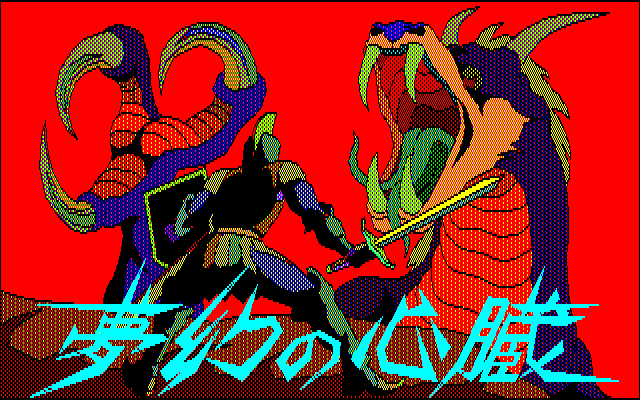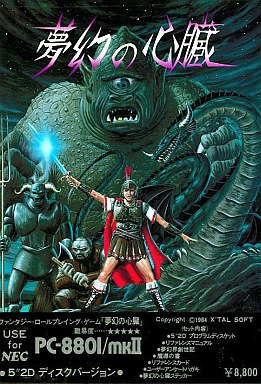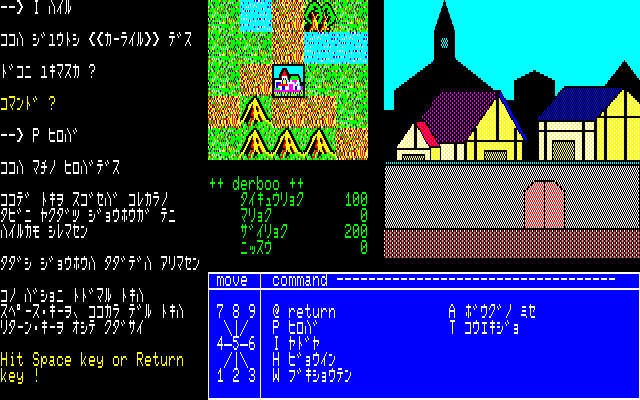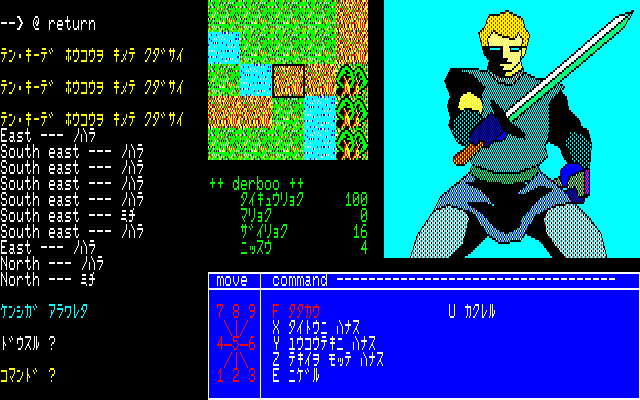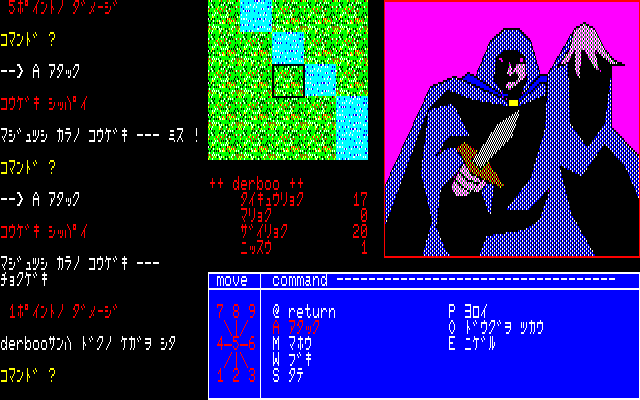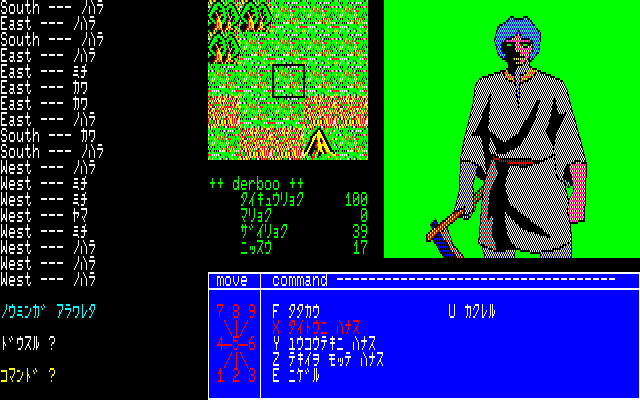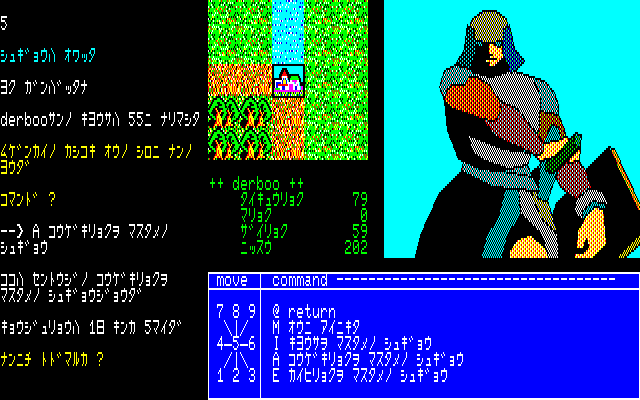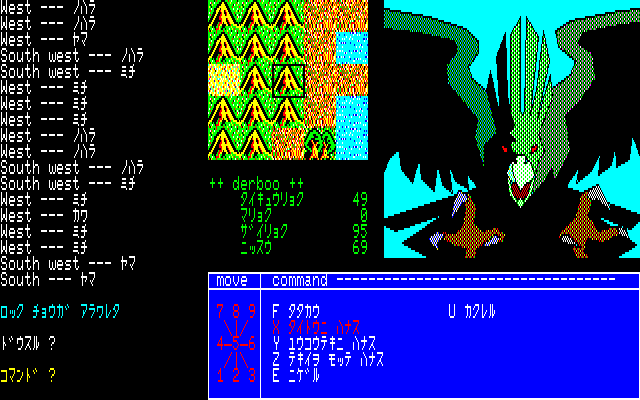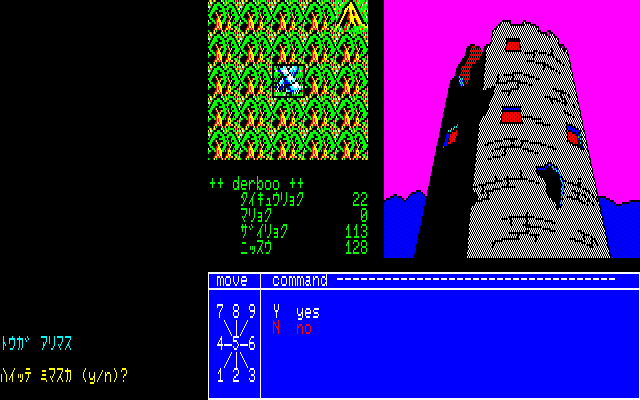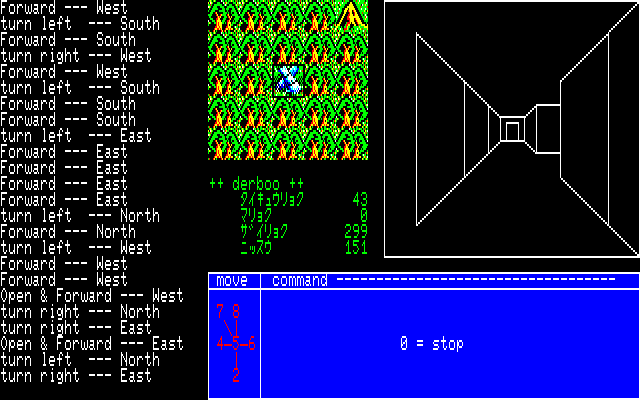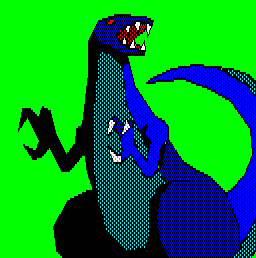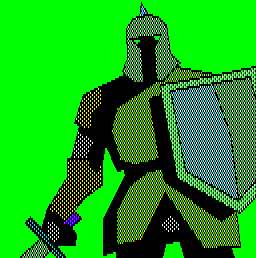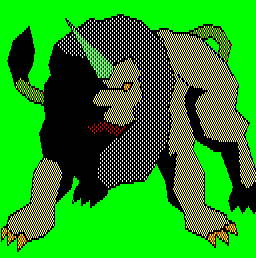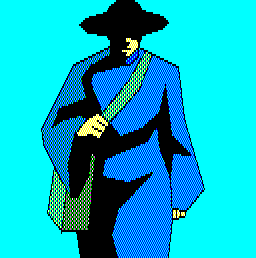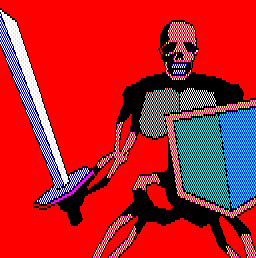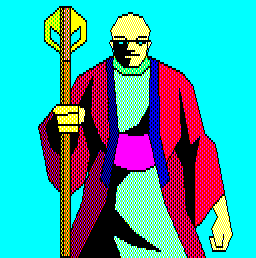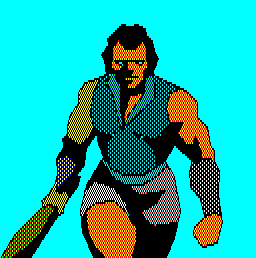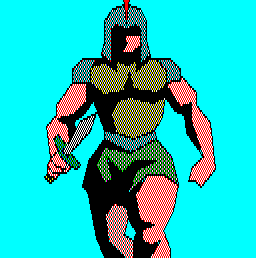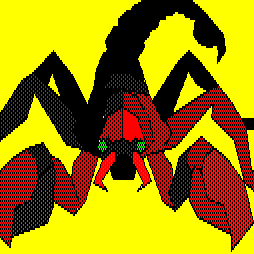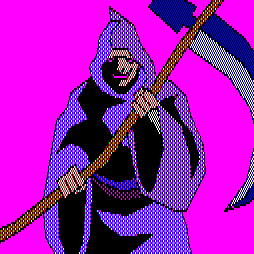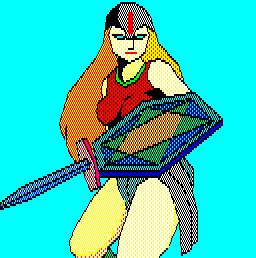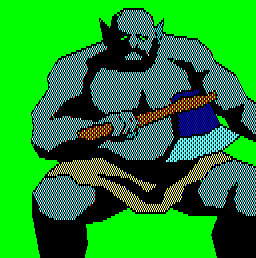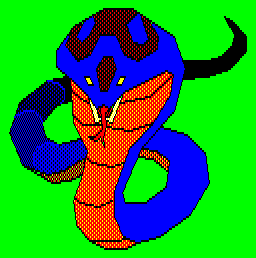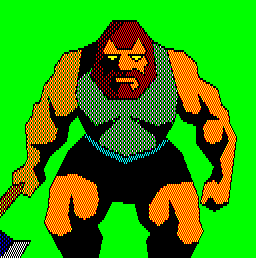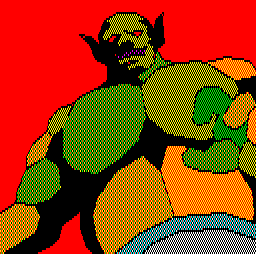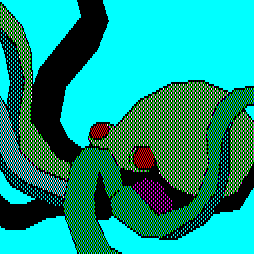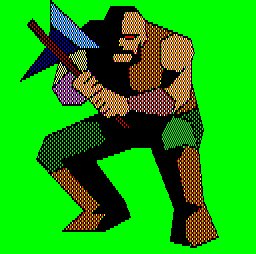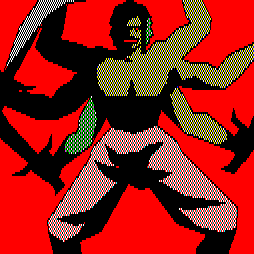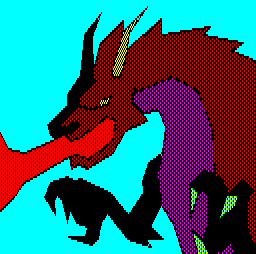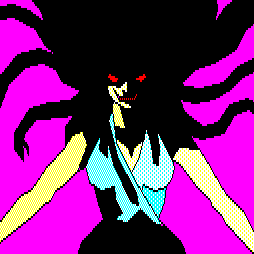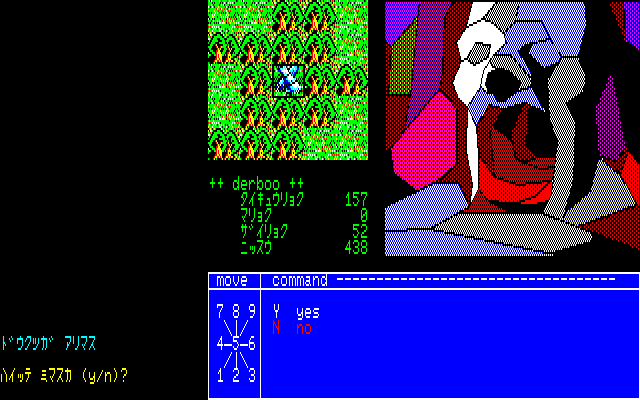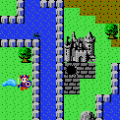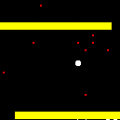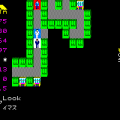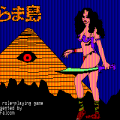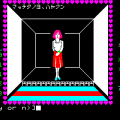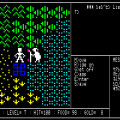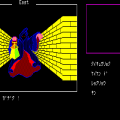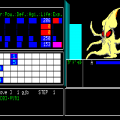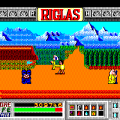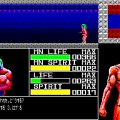I promised we’d meet Xtal Soft again soon, didn’t I? Mugen no Shinzou (“Heart of Fantasy”) is actually their first RPG and one of the most well-regarded Japanese computer RPGs. The Japanese Wikipedia entry on Hydlide describes it as one of the “big three” of Japanese CRPGs (the other two being Dragon Slayer and Hydlide), although that distinction may mostly come from its sequels. All in all, the series spans three titles, which were released about a year apart from each other.
Mugen no Shinzou was developed by Kazunari Tomi and one K. Kawahara. Lunar fans will probably remember the former as the creator of that series; after Mugen no Shinzou he did a few more games for Xtal Soft (including Mugen no Shinzou 2) before switching to Falcom, where he worked on Sorcerian and Dinosaur. As for Kawahara, I couldn’t confirm 100% that it is the same person, but “K. Kawahara” appears credited for the Surlent scenario in Rudra no Hihou and a Katsuyoshi Kawahara directed the Final Fantasy remakes for PlayStation.
The game is also frequently cited as one of the influences for Dragon Quest. While I’m not sure Koichi Nakamura and Yuji Horii conceded as much directly (this lengthy conversation between Horii and his friend and later Dragon Quest collaborator Akira Sakuma seems to imply that they have at least played it), it sure does seem to make a lot of sense when playing it.
According to the plot, the protagonist is nearly killed in the real world, but gets rescued and spirited away by a god, ending up in a fantasy world full of dragons, goblins and other monsters. If those who enter don’t find their way back to the real world soon, they are turned into monsters themselves and damned to eternal suffering. Thus the game actually has a “time” limit (although since the game is turn-based that translates to a turn limit) of 30,000 days. Moving every few steps advances the timer.
The game takes a lot of inspiration from Ultima, although like in Poibos the hero is merely a rectangle on a tiny window view of the map during overworld exploration. Another characteristic Mugen no Shinzou shares with Poibos is the fact that you won’t survive most enemy encounters. At least the game starts next to a town, which is navigated in menu form. Resting in the inn to heal is fortunately quite cheap, but everything else is ridiculously expensive, resulting in the game’s big similarity to Dragon Quest: It’s basically just one huge, long, boring money grind.
The first enemy I was actually able to defeat was the above thief, but he poisoned me before he went down, and curing poison costs a lot, so I ended up spending more money than I earned on the fight. Which I soon learned is characteristic for most fights in this game.
Then I finally happened upon a peasant. Human characters usually don’t attack you rightaway, and you can choose between three different attitudes when encountering them. It’s also possible to flee or hide on sight, but doing so costs a few experience points. Experience points don’t seem to do anything, though, so it’s not too bad a deal. The peasants probably are the most friendly enemies, but killing them really is the only way to make any (very slow) progress. They drop almost nothing for money, but are not too hard to defeat, and if you’re really lucky you can get their sickle to sell in town for like 25 gold pieces.
So after heroically slaughtering peasants for a few hours I saved up some money to spend. The most important stop in the town is the hospital. Here you can heal the hero entirely (which costs 100 gold vs the 4 gold to heal 25 points in the inn, so it’s only worth it much later as you start with a mere 100HP), cure poison for 20 gold or extend the maximum amount of HP by a few. The next town you get to when traveling west has a castle. Getting an audience with the king costs 500 gold, so I never met him, but you can train strength, agility and dexterity, but the amount you can learn here is limited. At least it makes enough difference so you can successful fight most human enemies.
You may save for better weapons or armor to get a bit stronger, but you’ll soon find out that every piece of equipment is destructible, and especially armor is so expensive that you better get used to fighting most battles naked and unarmed, until you get lucky and capture an enemy’s weapon. Luck is a huge part of things, anyway, as the random factor is much too high. You may defeat an enemy with ease, only to get hopelessly slaughtered in the next encounter with the same type. There’s not much tactics to the fights, either, as you got only one guy who can either attack, change his gear or try to escape. There’s a “spell” option during combat, too, but I never got far enough to learn any magic.
Don’t ever run off the path, cause in the woods and mountains you’re likely to get attacked by beasts, and they mean always trouble.
Sometimes when you’re being nice to road encounters, they tell you some piece of information, usually the location of an interesting point of the map. I was directed to a poisonous well in the woods once, but usually the destination was a dungeon.
Entering here resulted in a pitch black graphics window, so I had to go back to town to buy a lamp and oil (at least there’s no food management). This reveals a wireframe grid dungeon like in the early Ultima and Wizardry games. The tower I went into seemed rather huge, but had no distinguishing features other than a single trap right near the entrance, which just draws a lot of health when triggered. Apparently it’s possible to get a map of the dungeons, but I never found one. The monsters here are quite a bit stronger than the human enemies outside (though nowhere near as destructive as the beasts in the wilderness), so usually after two or three fights I’m forced to back out. Mugen no Shinzou might be the most mechanically sound game I’ve played so far for this series, but the odds are still stacked far too heavily against the player. After 6-8 hours, I had just barely grinded my HP up to 200 and yet could barely make any money to get it up further.
Xtal Soft have to be lauded for the graphics, though. The world map view and wireframe dungeons may not be too special, but the game contains a ton of detailed enemy graphics. I hardly got anywhere in this game, and still met more than 20 different enemies.
Here is a Japanese Blog of a guy who actually managed to finish this game. You can see some more great monster graphics in some of the later posts.
Previous Episodes:
(1) The Dragon and Princess
(2) Some games we cannot play
(3) Danchizuma no Yuuwaku (NSFW)
(4) Ken to Mahou
(5) Dungeon
(6) Seiken Densetsu
(7) Panorama Toh
(8) Do Dutch Wives Dream of Electric Eels (NSFW)
(9) Some more games we cannot play
(10) Courageous Perseus
